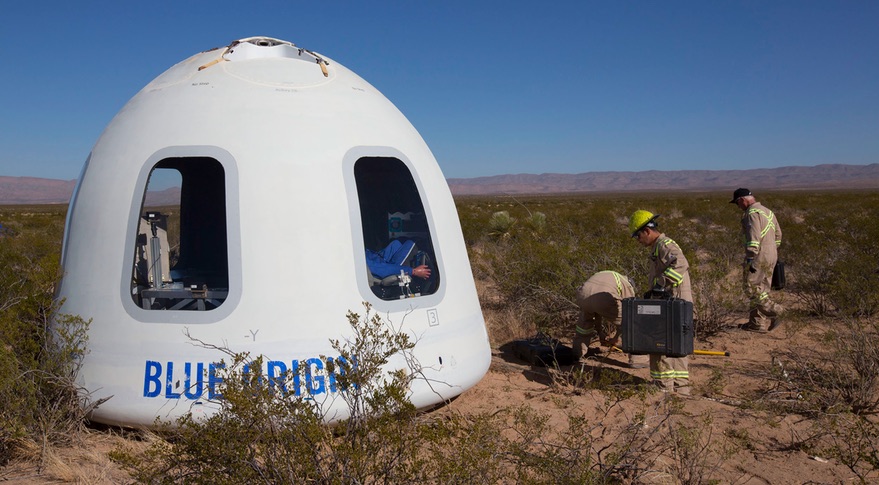Blue Origin a year away from crewed New Shepard flights

BROOMFIELD, Colo. — After carrying out a successful test flight of a new version of its New Shepard suborbital spacecraft, a Blue Origin executive said Dec. 18 that the company was now about a year away from starting to fly people.
Speaking at the Next-Generation Suborbital Researchers Conference (NSRC) here, Jeff Ashby, a former NASA astronaut who is director of safety and mission assurance for Blue Origin, said the Dec. 12 flight of the vehicle from Blue Origin’s test site in West Texas was a major milestone for the company.
That flight featured both a new version of the cylindrical propulsion module as well as “Version 2.0” of its crew capsule, now outfitted with the large windows that are a distinctive feature of the spacecraft. The capsule carried 12 experiments as well as a test dummy, dubbed “Mannequin Skywalker,” to measure the environment a human would experience on those flights.
The flight was the first in more than a year for New Shepard, after the final test flight in October 2016 of the previous version of the vehicle. “We learned a lot from it, which is why you saw the one-year hiatus before we began flying again,” Ashby said. That time allowed the company to make the vehicle more reliable and “human-capable,” he said.
Besides being a successful demonstration of the new flight hardware, the test flight was the first performed under a launch license awarded by the Federal Aviation Administration in August. Previous test flights took place under an experimental permit, which is designed to streamline the regulatory process for suborbital vehicle testing but does not allow the vehicle to carry cargo for hire.
“You have to be licensed in order to collect revenue,” Ashby said. “So last week was the start of a revolution. It was our first revenue flight for payloads: a huge, historic moment for us.”
“This was our first commercial flight, which in many ways was the flight that I had been waiting for since my first NSRC,” said Erika Wagner, business development manager at Blue Origin, said during a panel discussion later at the conference. “We had paying customers on board, both NASA and commercial.”
Blue Origin will continue to carry research payloads on future test flights of the vehicle. Wagner said the manifest for 2018 is largely full now, although the company said not disclosed a schedule of flights of the vehicle.
The company plans to later fly humans, both as payload specialists for human-tended experiments as well as on tourist flights. Those flights, though, are still at least a year away.
“We’re probably a year and a half, two years out from when we’re actually able to fly tended payloads,” Ashby said. “We’re about roughly a year out from human flights, depending on how the test program goes. We have a bunch more tests to do, and we’re going to fly some human test flights before we put paying people in the rocket.”
Blue Origin has yet to start selling seats on New Shepard flights. “We have not yet opened our website for tickets yet, and we won’t do that until we’re flying the versions of the rocket and capsule that people will ride on, to be delivered some time next year,” he said. “But we think there’s a lot of interest.”
Ashby said the development of New Shepard, along with the reusable first stage of SpaceX’s Falcon 9, was part of a “revolution” in spaceflight. He recalled a meeting a decade ago convened by Air Force Gen. Kevin Chilton, head of Air Force Space Command, that included experts from NASA and the Air Force Research Laboratory to examine ways to reduce launch costs.
“The sense in that meeting was that flyback or rocketback boosters were not a viable way to proceed,” he recalled. Such boosters, the meeting concluded, cost too much payload to preserve payload for a landing and, “based on the space shuttle experience, couldn’t be made to be operational.”
What changed, he said, were improvements in computer systems that enabled pinpoint landings, as well as autonomous flight termination systems. He also credited the “deep-pocketed investors from the dot-com era that had a passion for space,” like Blue Origin founder Jeff Bezos.
“It is an amazing time,” Ashby said. “What was unfeasible — and, even if it could be done, they said uneconomical — is now becoming commonplace.”
Related
ncG1vNJzZmiroJawprrEsKpnm5%2BifKO41J5kqKqZnLavecBmsJ6ZomKuuK3YZp2rp51isLOx1p6bZqaVrHq0tMSpmKucXZu5qrPHrapo